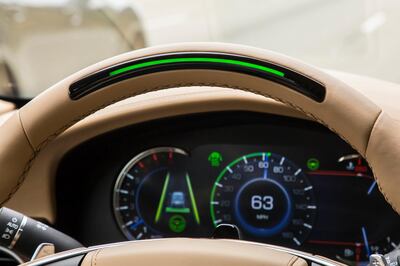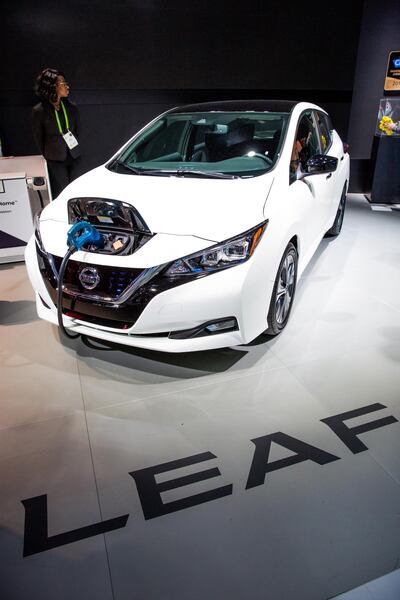The unstoppable ascent of autonomous driving has once again been in the news spotlight thanks to this year's Consumer Electronics Show (CES) in Las Vegas and proposed new guidelines in the United States on self-driving cars. The leaps in technology are, frankly, remarkable. And although the most complex systems are largely unproven in the real world, the rate of development appears to be accelerating, with a clutch of the latest cars on the market already offering semi-autonomous delights.
Audi claims its A8 is the first to reach level 3 (conditional automation) on the five-stage development of driverless vehicles (level 5 is full automation). One of its trump cards is its Traffic Jam Pilot, which allows it to accelerate, brake and steer itself at speeds of up to 60 kilometres per hour.

Nissan is set to launch its Leaf electric vehicle for the first time in the UAE later this year, and its ProPilot offers similar slow-speed traffic navigation, which The National tested last week in Nevada.
In the US, Cadillac has unleashed Super Cruise, which we also experienced last week and review in tomorrow's Weekend edition. The comic-book-sounding system allows for impressive hands-free highway navigation, with an option for the car to be able to park itself.

Tesla’s Autopilot has been a pioneer in the field; it would almost be easier to list the other major automakers who aren’t getting tooled up in the autonomous arms race. Equal to the excitement catalysed by this brave new world, however, are theoretical concerns and looming logistical nightmares. A gathering storm of legal red tape certainly seems set to entangle attempts to remove human control from the motoring equation.
Apart from the fact that phoning your insurance company for a quote on a driverless vehicle would currently cause confusion at the other end of the line akin to asking for fully-comp cover on the Starship Enterprise, as automation hits an intermediate stage, determining fault in accidents becomes a massive minefield.
If your autonomous car accidentally runs a red light and crashes into, to pick a random manufacturer for alliterative impact, a person-piloted Porsche, can you be blamed and forced to cough up for the prang? Worse still, what if the accident injures or kills somebody? Simply put, the law and the insurance industry – not to mention the UAE’s ever-busy Saaed – are not yet equipped to deal with all of the ramifications.
There are numerous infrastructure shortfalls that need to be met before a fail-safe system will be possible, too. The UAE, largely, is still planning how to be set up for these great leaps forward. Dubai’s self-flying taxis and the mini transport pods at locations such as Masdar City are impressive, no doubt, but on regular roads, much work has to be done.
Reliable mapping and a network of sensors along highways are required before you will be able to punch an address into your satnav and sit back until you reach your destination. Even in the countries leading the autonomous revolution, such as the US and Japan, the systems are highly reliant on road markings – so imagine the upgrades that will be necessary across less-maintained highways in many locations across the Mena region.
In areas undergoing roadworks, markings that have been painted over can confuse lane-keeping technology, something that I experienced recently on the outskirts of Dubai while employing the lane-keep assist on a Mercedes-Benz S-Class. At one point, the car suddenly detected what it thought was the central-reservation marking of the outside lane. It was actually a painted-over line in the middle of the carriageway that was not related to the temporary lanes through an area of bridge construction. Without warning, the wheel lurched right – only a swift manual intervention avoided the car broadsiding traffic on the inside.
During my Nissan Leaf test drive, the car frequently struggled when lanes were divided by “turtles” (the American answer to cat’s eyes). Come the time when level 5 automation is engaged, and you are snoozing in the back seat or engrossed in the latest bestseller, these metaphorical and literal bumps in the road will have to have been resolutely smoothed out.

During the transitional phase, where driverless and driver-controlled vehicles will co-exist, there is plenty of work to be done in educating humans and the autonomous cars alike. A recent survey in the US found that 64 per cent of respondents were concerned about sharing roads with driverless vehicles. And then there are other variables that won’t be able to “talk” to each other via technology. “The hardest point is not the vehicle-to-vehicle situation – it’s bicycles, college-town crosswalks,” Michigan governor Rick Snyder said at CES, while also expressing concerns about how the brave new dawn could see droves of professional drivers put out of work.
Vast differences in driving styles and standards from country to country throw up almost limitless conundrums. For example, in the Middle East when a driver flashes their headlamps, it generally means: “Mind out... I’m coming through.” Whereas in, say, the United Kingdom, a similar application of your lights usually indicates that you are giving way to an oncoming car.
Autonomous cars would, therefore, presumably, have to have settings adjusted according to geography, with rules of the road and colloquial variants all encompassed. But then what happens if you drive your car to a neighbouring country – possibly, in some continents, with traffic using the opposite side of the road to your home base? Or more complex still, how will the AI be fiddled with to account for places such as the UAE, where dozens and dozens of nationalities share the same tarmac?
Dr Melissa Cefkin, principal researcher with Nissan, is a cultural anthropologist whose work focuses on the “social dimensions” of more autonomous vehicles on the road. She thinks that a small number of additional exterior indicators might need to be added to cars. “In terms of regularising the signals, we would aim to develop a language or a vocabulary,” she explains. “I think any additional signalling would be very minimal and very few of them; they will need to be quite simple to understand and there would be an education process.”
The more you consider the issue, the more potential problems rear their heads. How will autonomous vehicles cope with a traffic-light failure? How can they be programmed to respond to human hand signals, such as from cyclists or law-enforcement officers?
The possibility of hacking by nefarious people and organisations, from nihilistic children to international terrorists, has also been a huge talking point, so impregnable cyber security is high on the list of developmental priorities.
Weather conditions can also prove incredibly hazardous. Snow or standing water covering road markings can throw off sensors, while Nissan’s ProPilot apparently encounters difficulties if your windscreen wipers are operating at anything more than intermittent levels. Fine for 11 months a year in the UAE; less fun when rare torrential deluges hit.
On the flip side, the potential is huge. Some analysts have already gone so far as to suggest that driverless cars, in expanding the potential for previously unrealistically lengthy commutes, could even put paid to the idea of drivers having one permanent home. But that is surely a long way off, particularly considering that most people aren’t the possession-free cloud-dwellers than many in Silicon Valley might assume.
In the meantime, it seems that for every futuristic flight of fancy, another half dozen real-world concerns about autonomous vehicles will act as sensible ballast weighing down the speed of our progress.
_______________
Read more:
[ Special report: How the internal combustion engine is running out of road ]
[ Driverless cars: GM to ditch steering wheel and pedals to put robot in charge ]
[ Test drive: 2018 Nissan Leaf ]
_______________






